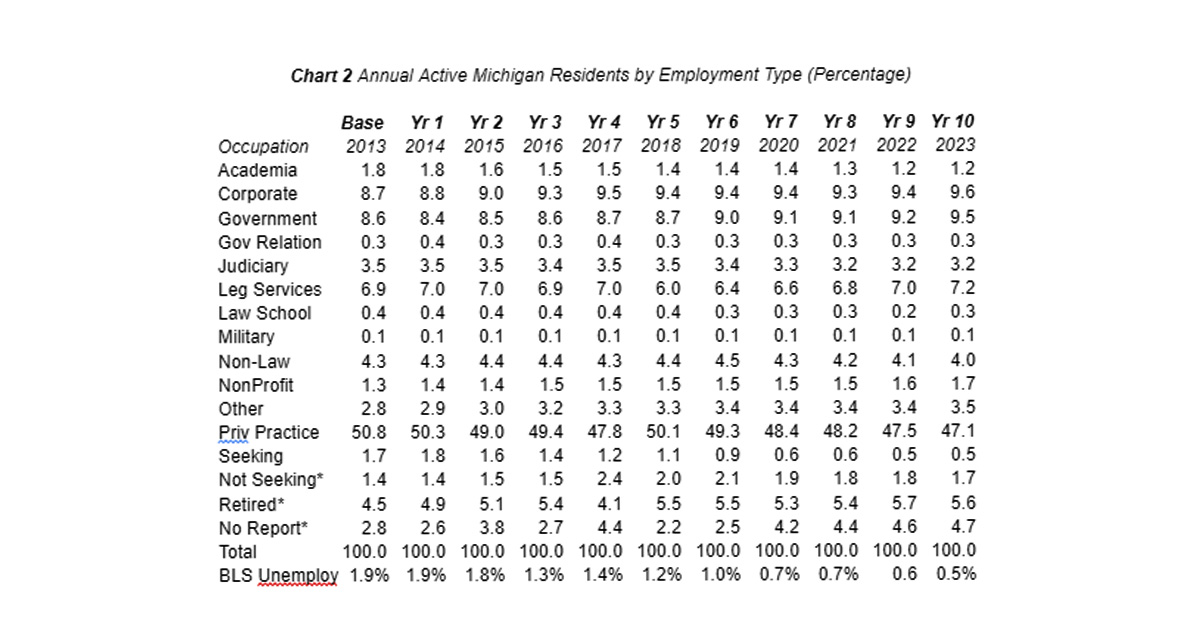How Are Michigan Lawyers Employed in 2023? – Part 1

Michigan Resident Lawyer Employment Data Series – Part 1 by Don LeDuc, Professor of Law, Cooley Law School
Annually, the State Bar of Michigan collects detailed data regarding its membership, focusing on active Michigan resident lawyers–a focus followed in the seven-part analysis in this series. The data is supplied by and used with the permission of the State Bar. My thanks to Kristen Sewell, the current Research and Analytics Director at the State Bar of Michigan and Anne Vrooman, recently retired from that position, for their work in gathering and providing this information. The data provides an opportunity to examine objectively both the changes from year-to-year and the implications of those changes.
This first part focuses on the employment types reported by Michigan’s active resident lawyers. It charts the data by occupational type, using 2013 as the base year and covering the 10 following 10 years. Chart 1 looks at the numbers; Chart 2 displays the percentages.

*The Bureau of Labor Statistics, a unit within the United States Department of Labor, supplies national employment information. The BLS includes only those who are active in the labor market to establish the number for the denominator; it includes only those who are unemployed and actively seeking employment for the numerator. To compare Michigan lawyer employment data to the more familiar BLS measures, adjustments to the State Bar data are required to exclude those (1) whose status is not reported, (2) who are not seeking employment, and (3) who are retired. These are shown with an asterisk on Charts 1 and 2 and are excluded in the calculation of Michigan lawyer unemployment. [Michigan’s situation is complicated by the presence of retired lawyers among the active bar membership. Retirement generally implies that these active members likely are not seeking employment, so they are excluded from both the numerator and the denominator.]
Chart 1 displays the resulting numbers. In 2023, 743 of Michigan’s 34,675 resident lawyers reported that they were unemployed, yielding an unadjusted or “raw” unemployment rate of 2.1%. Removing the three non-market BLS employment categories from the Michigan denominator calculation allows comparison to national unemployment rates: (1) the number not reporting their status increased from 968 in 2013 to 1,637 in 2023; (2) the number unemployed, but not seeking employment, rose from 469 to 582 during that period; and (3) the number of retired lawyers increased from 1,527 to 1,952. Combined, these categories increased from 2,964 in 2013 to 4,171 in 2023, reducing the denominator in the Michigan calculation by 1,207.
Combined with other factors, the Michigan denominator decreased by a net 736. The active resident lawyer total was affected by moderately increasing numbers through 2019, then by moderately decreasing numbers thereafter. The total fell by 685 over the last four years, or about 2%. Over this later period, fewer law students were graduating, and the number of graduates passing a bar examination fell. [One must first become a lawyer in order to become an employed or unemployed lawyer.] Some lawyers moved out-of-state; some lawyers dropped their bar memberships; some lawyers died. Because these factors push the denominator down, the unemployment rate moves upward.
These adjustments occurred while the number of lawyers migrating to Michigan from elsewhere rose. Lawyer ranks increased steadily during the years preceding this study’s reporting years. The increases in lawyer numbers from earlier years added many younger lawyers who were likely to be retained as members during the period under study here. Apparently, lawyers continued working later in life. By 2023, the BLS adjustments and these other factors combined to reduce the 34,675 total resident Michigan lawyers to 30,504 lawyers active in the lawyer employment market. Thus, while the unadjusted total of lawyers in the employment market increased by 471 or 1.4%, the adjusted total declined by 736 or 2.4%.
But during the same period (particularly after 2014), the overall number of unemployed lawyers reportedly seeking employment fell from 590 to 161. This reduced the numerator number steadily and by 72.7 percent. When the numerator moves down, so does the unemployment rate. Here, the numerator decline was much greater than the decline in the denominator, producing an overall decline in the unemployment rate.

Chart 1 showed the numerical annual history of Michigan lawyer employment by employment type. Chart 2 displays the annual percentages based on the numbers in Chart 1. It uses the “unemployed, seeking employment” number as the numerator in the calculations. The result demonstrates that while decreases in the denominator pushes the unemployment percentage up, decreases in those seeking employment–the numerator–sends the unemployment percentage down, producing a decidedly more precipitous negative net change.
Contrary to the assumption of some critics and observers, the unemployment rate for Michigan lawyers has been low and steadily falling over the past ten years. The 1.9% rate of 2013 fell to 1% by 2019 and to 0.5% by 2023. This final rate is lower than the July 2023 reported national unemployment rate of 3.9% reported in September. Both are good news for those enrolled in law school today, as well as for those thinking about applying to law school today.
Next, look for the upcoming analysis of the changes in occupational type over the last decade in Part 2 of the Michigan Resident Lawyer Employment Data Series by Don LeDuc, Professor of Law, Cooley Law School.

